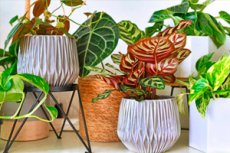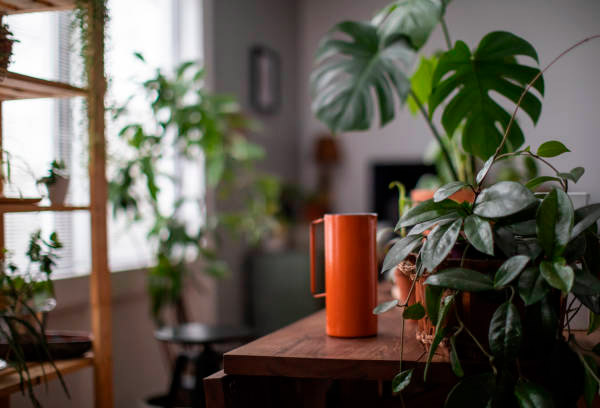Humidity and air conditioning for houseplants
Last reviewed: 29.06.2025

Air humidity plays an important role in the life of houseplants, affecting their growth, development, and overall health. The right level of humidity promotes efficient photosynthesis, strengthens cell walls, and enhances resistance to diseases and stress conditions. In modern housing, where air conditioning and heating systems are commonly used, maintaining optimal humidity levels becomes especially important. This article will discuss the significance of humidity for plant growth, its impact on various plant species, and methods for regulating humidity indoors.
Importance of humidity for plant growth
Air humidity, or relative humidity (rh), is the percentage of water vapor in the air compared to the maximum amount possible at a given temperature. For houseplants, the optimal humidity level varies depending on the species but generally falls between 40% and 60%.
Functions of moisture for plants:
- Photosynthesis: air humidity affects the ability of plants to absorb carbon dioxide through the stomata. Low humidity can slow down this process, reducing photosynthesis efficiency.
- Transpiration: water absorbed by the roots rises through the stems and evaporates through the stomata of the leaves. This process helps plants regulate their temperature and transport nutrients.
- Growth and development: sufficient moisture levels support cell growth, tissue strengthening, and root system development.
Impact of humidity on plants
- Low humidity (below 40%):
- Problems: wilting leaves, brown tips, slow growth, increased susceptibility to diseases and pests.
- Plants: tropical plants such as ficus, spathiphyllum, and orchids are particularly sensitive to dry air.
- High humidity (above 60%):
- Problems: fungal diseases, mold growth, root rot, slowed growth.
- Plants: succulents and cacti, which prefer dry conditions, may suffer from excess moisture.
Methods of regulating humidity indoors
- Natural methods:
- Grouping plants: placing several plants together creates a microclimate with increased humidity through water evaporation from the leaves.
- Water pots: place pots of water near plants. The water will evaporate, raising the humidity around the plants.
- Using wet cloths: place wet cloths or towels near plants or suspend them above them to increase humidity through evaporation.
- Water spraying: regularly spraying the leaves with water can temporarily increase humidity. However, this method may not always be effective and can contribute to mold development if excess moisture is present.
- Mechanical methods:
- Humidifiers: specialized devices that consistently maintain a set humidity level. They are particularly useful in winter when heating systems dry out the air.
- Air conditioners with humidification: some modern air conditioners come equipped with humidifying functions, which allow you to control humidity alongside temperature.
- Fans with humidifiers: these devices combine the functions of a fan and a humidifier, ensuring even distribution of humid air throughout the room.
- Environmental modifications:
- Using hygrometers: installing a hygrometer helps accurately control humidity levels and make adjustments as needed.
- Mulching soil: mulching the soil (using pebbles, bark, perlite) helps retain moisture, reducing evaporation and maintaining stable humidity levels.
- Vertical gardens and hydroponics: these systems offer more efficient moisture and nutrient management, promoting healthy plant growth.

Recommendations for ensuring optimal humidity for different plant types
- Tropical plants (ficus, spathiphyllum, orchids):
- Optimal humidity: 60-80%
- Methods to increase humidity:
- Use humidifiers.
- Group plants together.
- Regularly spray the leaves.
- Place plants in naturally humid areas, such as bathrooms.
- Succulents and cacti:
- Optimal humidity: 20-40%
- Humidity regulation methods:
- Avoid overwatering and ensure a good drainage system.
- Place plants in well-ventilated areas.
- Use dry soil and minimize excess moisture sources.
- Flowering plants (geraniums, begonias, philodendrons):
- Optimal humidity: 40-60%
- Humidity regulation methods:
- Regularly spray the leaves.
- Use humidifying trays or water pots.
- Humidifiers help maintain a stable humidity level.
- Leafy plants (pachira, sansevieria, zamioculcas):
- Optimal humidity: 40-60%
- Humidity regulation methods:
- Regular watering and maintaining soil moisture.
- Group plants together to create a microclimate.
- Use trays with gravel and water.
Additional tips for regulating humidity
- Proper watering: ensure proper watering practices by avoiding overwatering or underwatering. Use moisture meters or the finger test to check soil moisture before watering.
- Choosing the right location: place plants in spots where they receive adequate natural light, but avoid direct sunlight that may dry out the air.
- Using companion plants: some plants help maintain humidity due to higher water evaporation. Ferns, for example, can be excellent companions for other houseplants.
- Seasonal changes: in winter, when heating systems dry out the air, increase humidity with humidifiers or additional moisture sources. In summer, when humidity is higher, ensure plants do not suffer from excessive moisture.
Conclusion
Maintaining optimal air humidity is a crucial aspect of houseplant care. Understanding the needs of different plant species and using effective humidity regulation methods will create favorable conditions for their growth and prosperity. By combining natural and artificial methods, you can achieve stable humidity levels that support the health of your green companions and improve the indoor atmosphere. Regular monitoring and adapting care routines based on changing conditions will help avoid common mistakes and ensure the long life of your plants.
Frequently asked questions (FAQ)
How to determine the current humidity level in a room?
Use a hygrometer — a device that measures relative humidity. Hygrometers come in various models, from simple analog to digital versions with additional features.
Can regular humidifiers be used for houseplants?
Yes, regular humidifiers are suitable for increasing air humidity in a room. However, make sure that the humidifier does not create excessively moist conditions that could lead to mold and fungal diseases.
What to do if the room has too low humidity, and the humidifier is not helping?
Try combining several methods: group plants, use water pots, place wet cloths near plants, and regularly spray leaves. Also, ensure proper air circulation to avoid areas of low humidity.
Can plants regulate the humidity of the air themselves?
Yes, plants help increase humidity through the process of transpiration.
Which plants are best suited for high-humidity environments?
Plants like ferns, spathiphyllum, philodendrons, and aloe vera are ideal for high-humidity rooms. They tolerate excess moisture well and can improve air quality.
